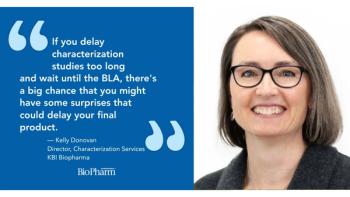
- BioPharm International-04-01-2019
- Volume 32
- Issue 4
Predictability Improves Prospects for Biopharma Patent Holders
While it may not be getting easier, biopharma patent protection is at least becoming more predictable.
Protecting biopharmaceutical patents has always been challenging, especially in the United States, birthplace of the biotech industry. In 2018, the US ranked 12th out of 50 nations in the world based on how effectively it protected its homegrown innovation, according to the US Chamber of Commerce’s annual Intellectual Property (IP) Index (1). It had ranked 10th out of 50 the previous year. In 2018, Andrei Iancu, then newly appointed director of the United States Patent and Trademark Office (USPTO), acknowledged the need for policies that would support innovators and increase the reliability of patents (2).
Overall, IP protection difficulties intensified in 2012 when the America Invents Act established the practice of using inter-partes review (IPR) to question patent validity (3,4). In 2018, the US Supreme Court upheld the constitutionality of IPRs (5). For biopharma patent holders, this decision means that the path going forward will be “a lot more certain than it had been,” says Kevin Noonan, Partner at McDonnell Boehnen Hulbert & Berghoff LLP and chair of the firm’s Biotechnology & Pharmaceuticals Practice Group.
Enhanced certainty around IPRs helped drive the US up from 12th to second place in the US Chamber of Commerce’s 2019 IP Index, according to Patrick Kilbride, senior vice-president of the Chamber’s Global Innovation Policy Center (6). For biopharmaceutical companies, which spend more on R&D than companies in any other industry in the US, patenting the companion diagnostics used in personalized medicine is extremely difficult, as was shown by the Sequenom case in 2015 (7). Kevin Noonan touched on changes and the new IP legal climate in an interview with BioPharm International.
IPR Patent invalidation
BioPharm: What impact did IPRs have?
Noonan: The bad patents were challenged first, and the invalidation rate for all industries was initially around 80–90%, but that number has since come down. The patent invalidation rate was never that high for biopharma, but it was still around 60%.
BioPharm: A few years ago, Allergan had transferred sovereign rights to its patent to a Native American tribe, to protect it against invalidation by the IPR. Since then, we’ve heard that the US Supreme Court will be asked to rule on agreements of this type. Will this type of defense continue in the future?
Noonan: It was a very clever attempt, but the approach, ultimately, has not panned out. The Supreme Court may intervene because its justices have tended to take the position that narrowing or expanding tribal immunity is within the province of Congress, so Congress can pass a law saying that sovereign immunity won’t apply in these cases. Two years ago, lawmakers introduced bills in Congress to do just that.
Strategies for antibodies
BioPharm: You have talked about IP protection strategies for antibodies, and use of the ‘written description’ concept. What is happening in this area?
Noonan: From 1996 to 2009, the concept was very controversial. It is based on the idea that, if you don’t describe an invention sufficiently, even if you have enabled someone else to make that invention, you aren’t entitled to a patent. This came up in the Ariad case (8). Last year, Chief Judge Prost changed the law and the way it was being applied to antibodies (9). The law now reads in a way that is consistent with the rest of the written description law that was sanctioned under Ariad. Basically, it says that the amount of description you have to do narrows the scope of the claims that you can get for antibodies in a way that would make it easier for a competitor to come on the market. This will make it more difficult for a patent holder to prevent a competitor from coming on the market. We’ll have to see whether that inhibits innovation in the space.
BioPharm: What is happening with diagnostics patents?
Noonan: Director Iancu is continuing efforts to make sense of, and better harmonize, the way that the patent office is examining applications for subject matter eligibility under 35 U.S.C. § 101 (10), and to try to do that in a way that is consistent with Supreme Court and other decisions.
Diagnostics claims are very important and they are part of personalized medicine. A lot of the IP surrounding that effort is falling afoul of the way that the patent office, district courts, and Federal Circuit have interpreted Supreme Court teachings on this matter. Two positive developments have been the Berkheimer Tech (11) and Vanda (12) cases. In Berkheimer, the court said that sometimes the question of whether or not something is patent eligible contains the question of fact. This is important because what often happens is that the infringer files a petition to dismiss a case, based on patent eligibility theory. The only way that they can get away with that approach is if the court decides that the decision is purely a question of law. In that case, there is no need to construe the claims and the court can do that itself. If you can convince the court that there is a disputed question of fact, it can get the patentee over the hump and into discovery, offering the innovator a chance to present information and evidence that will help the court make its decision.
In Vanda, the court ruled that method of treatment claims are patent eligible, almost per se, and that the issues that the Supreme Court was concerned about do not apply to a method of treatment. Vanda and Berkheimer are two rays of hope, after eight or nine years of negative press and negative outcomes.
US IP protection rankings fell in 2018 because of stories like Sequenom’s. The company had developed a blood test that would obviate the need for amniocentesis, and the court ruled it was not patent eligible. The company had put its blood, sweat, and tears into developing the test. The environment in the US is still not innovation friendly, and the result has been a chill on innovation, especially in personalized medicine.
References
1. US Chamber of Commerce,
2. A. Iancu, “
3. J. Ellis, Biotechnology Law Report, 34(5) (October 21, 2015).
4. A. Shanley, “Protecting Biopharm’s Intellectual Capital,” biopharminternational.com, July 1, 2018.
5. R. Schwartz and J. Engelhardt, “
6. US Chamber of Commerce, “
7. C. Brinckerhoff, “
8. K. Noonan, “
9. K. Noonan, “
10. United States Code 35,
11. S. Forbes and M. Fuller, “
12. J. Roglitz, “
Article Details
BioPharm International
Volume 32, No. 4
April 2019
Pages: 50–51
Citation
When referreing to this article, please cite it as A. Shanley, "Predictability Improves Prospects for Biopharma Patent Holders," BioPharm International 32 (4) 2019.
Articles in this issue
over 6 years ago
Cleaning Chromatography Resin Residues from Surfacesover 6 years ago
Channeling Customer Complaints into Qualityover 6 years ago
Continuous Manufacturing Gains Major Push from FDAover 6 years ago
Reinventing the Biomanufacturing Wheelover 6 years ago
Continuous Bioprocessing of Vaccinesover 6 years ago
Going Global in Biopharma Regulatory Affairsover 6 years ago
What’s New in Downstream Processingover 6 years ago
Science Focus Fuels Successful Process Development for StartupsNewsletter
Stay at the forefront of biopharmaceutical innovation—subscribe to BioPharm International for expert insights on drug development, manufacturing, compliance, and more.





